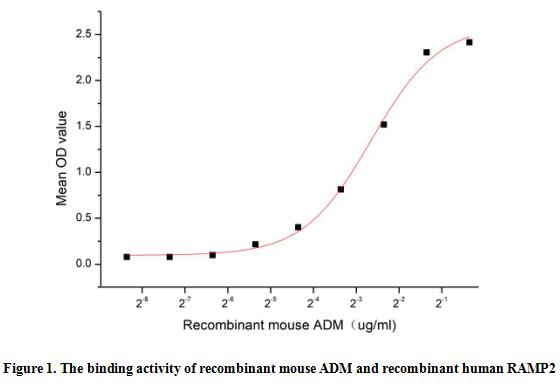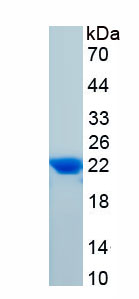Active Adrenomedullin (ADM) 

AM; PAMP; Proadrenomedullin N-20 terminal peptide; ProAM N-terminal 20 peptide
- UOM
- FOB US$ 296.00 US$ 740.00 US$ 1,480.00 US$ 4,440.00 US$ 11,100.00
- Quantity
Overview
Properties
- Product No.APA220Mu01
- Organism SpeciesMus musculus (Mouse) Same name, Different species.
- ApplicationsCell culture; Activity Assays.
Research use only - DownloadInstruction Manual
- CategoryEndocrinologyHormone metabolism
- Buffer FormulationPBS, pH7.4, containing 0.01% SKL, 5% Trehalose.
- Traits Freeze-dried powder, Purity > 90%
- Isoelectric Point10.1
Sign into your account
Share a new citation as an author
Upload your experimental result
Review

Contact us
Please fill in the blank.
Activity test

Adrenomedullin (ADM) is a peptide hormone first discovered in 1993 in pheochromocytoma. Although AM is highly expressed in the adrenal glands, heart, lungs, and kidneys, vascular endothelium and smooth muscle are thought to be the main source of plasma AM. It is a 52 aa peptide with several functions, including vasodilation, regulation of hormone secretion, promotion of angiogenesis, and antimicrobial activity. The antimicrobial activity is antibacterial, as the peptide has been shown to kill E. coli and S. aureus at low concentration. Receptor activity-modifying protein 2 can transports the calcitonin gene-related peptide type 1 receptor (CALCRL) to the plasma membrane. Acts as a receptor for adrenomedullin (AM) together with CALCRL. Thus a functional binding ELISA assay was conducted to detect the interaction of recombinant mouse ADM and recombinant human RAMP2. Briefly, ADM was diluted serially in PBS with 0.01% BSA (pH 7.4). Duplicate samples of 100 μl were then transferred to RAMP2-coated microtiter wells and incubated for 1h at 37℃. Wells were washed with PBST and incubated for 1h with anti-ADM pAb, then aspirated and washed 3 times. After incubation with HRP labelled secondary antibody for 1h at 37℃, wells were aspirated and washed 5 times. With the addition of substrate solution, wells were incubated 15-25 minutes at 37℃. Finally, add 50 µL stop solution to the wells and read at 450/630nm immediately. The binding activity of recombinant mouse ADM and recombinant human RAMP2 was shown in Figure 1, the EC50 for this effect is 0.16 ug/mL.
Usage
Reconstitute in 10mM PBS (pH7.4) to a concentration of 0.1-1.0 mg/mL. Do not vortex.
Storage
Avoid repeated freeze/thaw cycles. Store at 2-8°C for one month. Aliquot and store at -80°C for 12 months.
Stability
The thermal stability is described by the loss rate. The loss rate was determined by accelerated thermal degradation test, that is, incubate the protein at 37°C for 48h, and no obvious degradation and precipitation were observed. The loss rate is less than 5% within the expiration date under appropriate storage condition.
Increment services
-
 BCA Protein Quantification Kit
BCA Protein Quantification Kit
-
 Molecular Mass Marker for Protein
Molecular Mass Marker for Protein
-
 Monoclonal Antibody Customized Service
Monoclonal Antibody Customized Service
-
 Polyclonal Antibody Customized Service
Polyclonal Antibody Customized Service
-
 Protein Activity Test Experiment Service
Protein Activity Test Experiment Service
-
 Electrophoretic Mobility Shift Assay (EMSA) Experiment Service
Electrophoretic Mobility Shift Assay (EMSA) Experiment Service
-
 Buffer
Buffer
-
 Lentivirus Packaging Experiment Service
Lentivirus Packaging Experiment Service
-
 Adenovirus Packaging Experiment Service
Adenovirus Packaging Experiment Service
-
 Real Time PCR Experimental Service
Real Time PCR Experimental Service
-
 Spike RBD Protein (S-RBD)
Spike RBD Protein (S-RBD)
-
 Protein G
Protein G
-
 Protein A
Protein A
Citations
- Gingival crevicular fluid adrenomedullin level in individuals with and without diabetes mellitus type 2Wiley: Source
- Comparison of peri-implant crevicular fluid levels of adrenomedullin and human beta defensins 1 and 2 from mandibular implants with different implant stability quotient levels in nonsmoker patientsPubmed: 23898869
- Short-term hypoxia/reoxygenation activates the angiogenic pathway in rat caudate putamen.Pubmed: 23660671
- DNA methylation patterns in newborns exposed to tobacco in uteroPubmed:25623364
- Adrenomedullin—A New Marker in Febrile Neutropenia: Comparison With CRP and ProcalcitoninPubMed: 26271020
- Angiogenesis is VEGF-independent in the aged striatum of male rats exposed to acute hypoxia.pubmed:28501895
- Adrenomedullin and Galanin Responses to Orthostasis in Older Persons pubmed:28796366
- ADRENOMEDULIN DI KARSINOMA PAYUDARA DENGAN METASTASIS:
- Composition and cardioprotective effects of Primula veris L. solid herbal extract in experimental chronic heart failureDoi: 10.1016/j.phymed.2018.09.015
- Anti-Inflammatory and Pro-Inflammatory Neuropeptides in Dilative Cardiomyopathy are there Relations to Psychophysical Stress?
- Clinical and experimental investigation of the nervous system of neonatal foals. Neuroendocrin transition from foetal consciousness to perinatal life
- Hemodynamic Responses in Lower Limb Lymphedema Patients Undergoing Physical Therapy34356497







